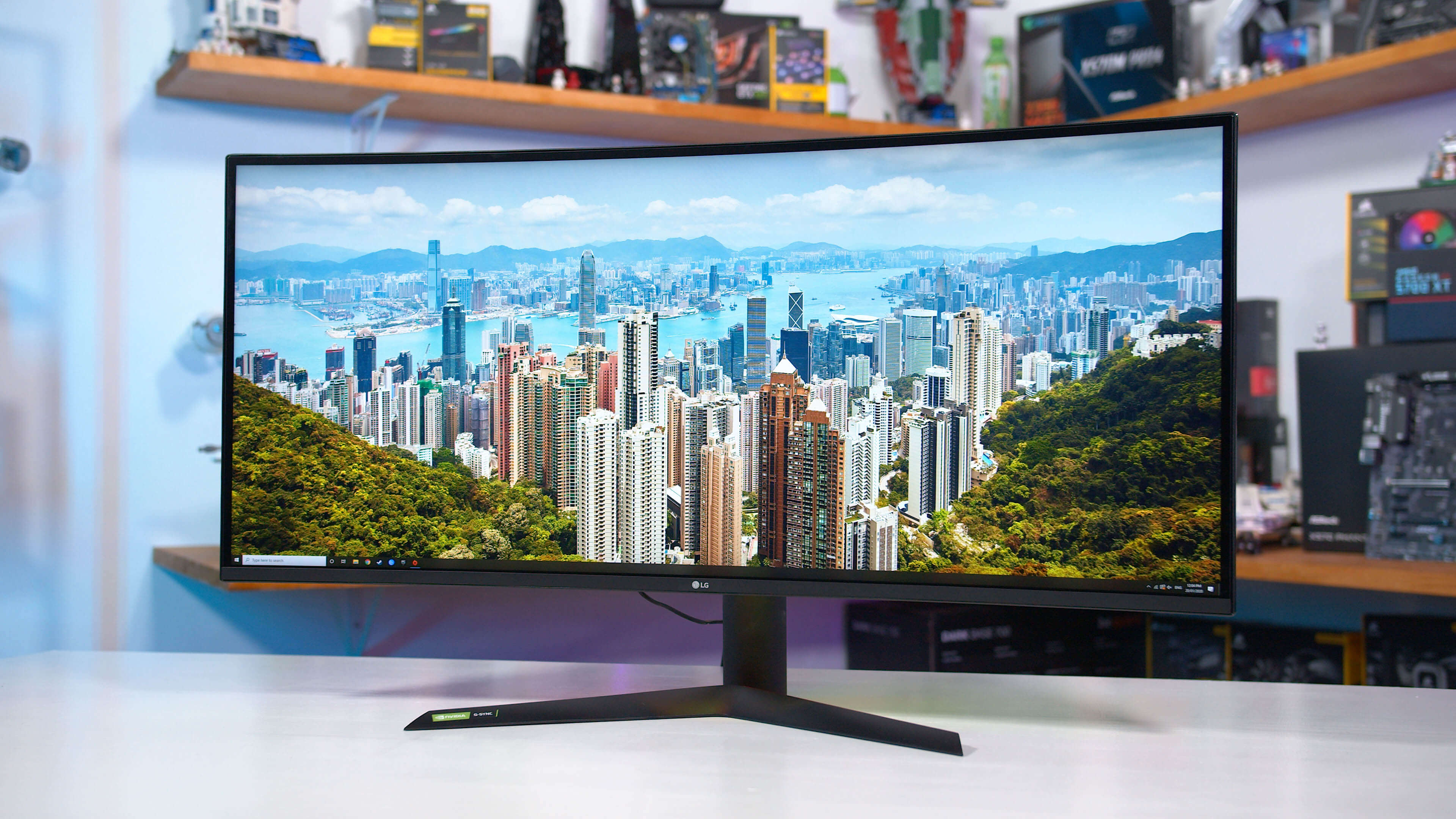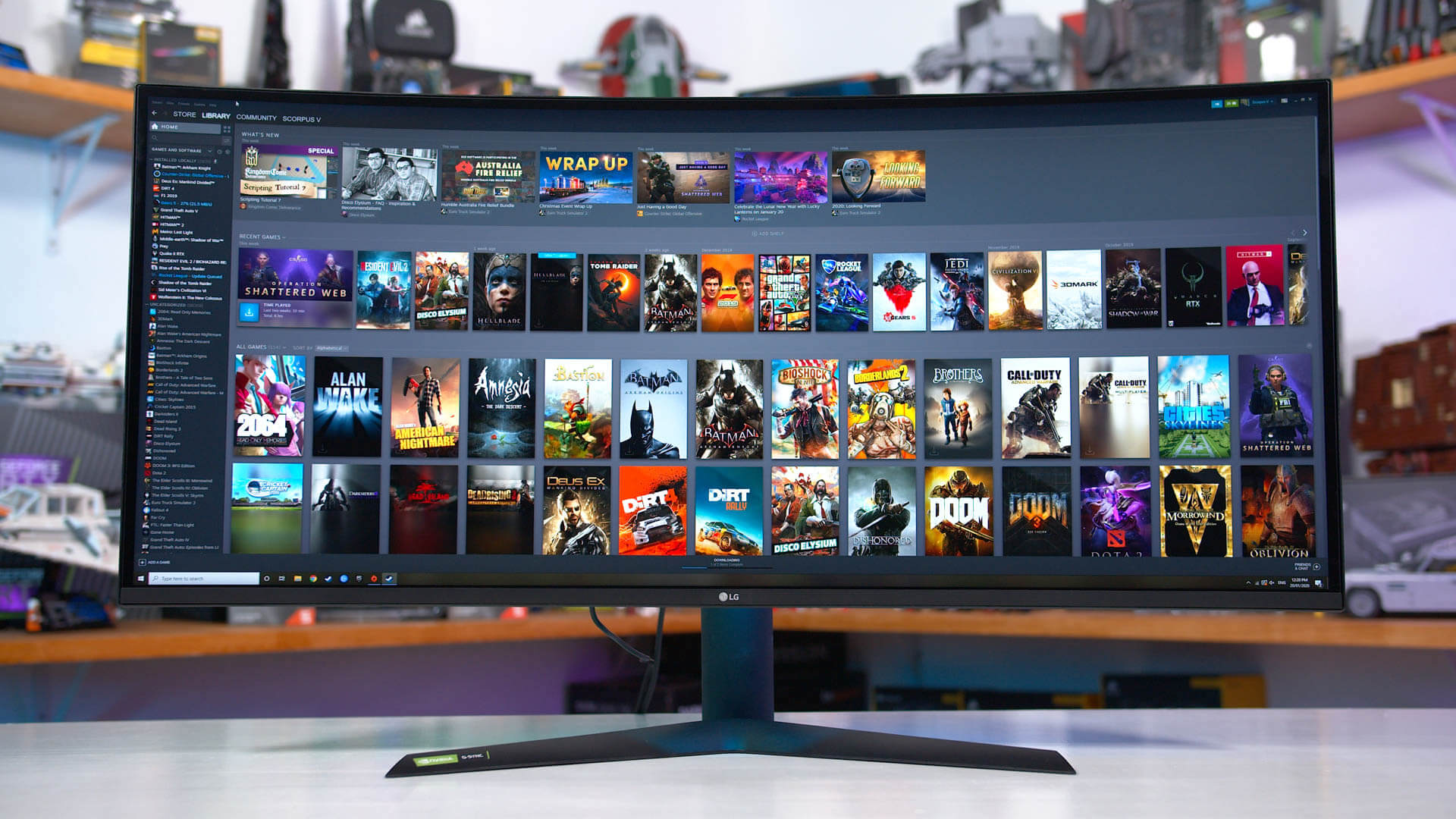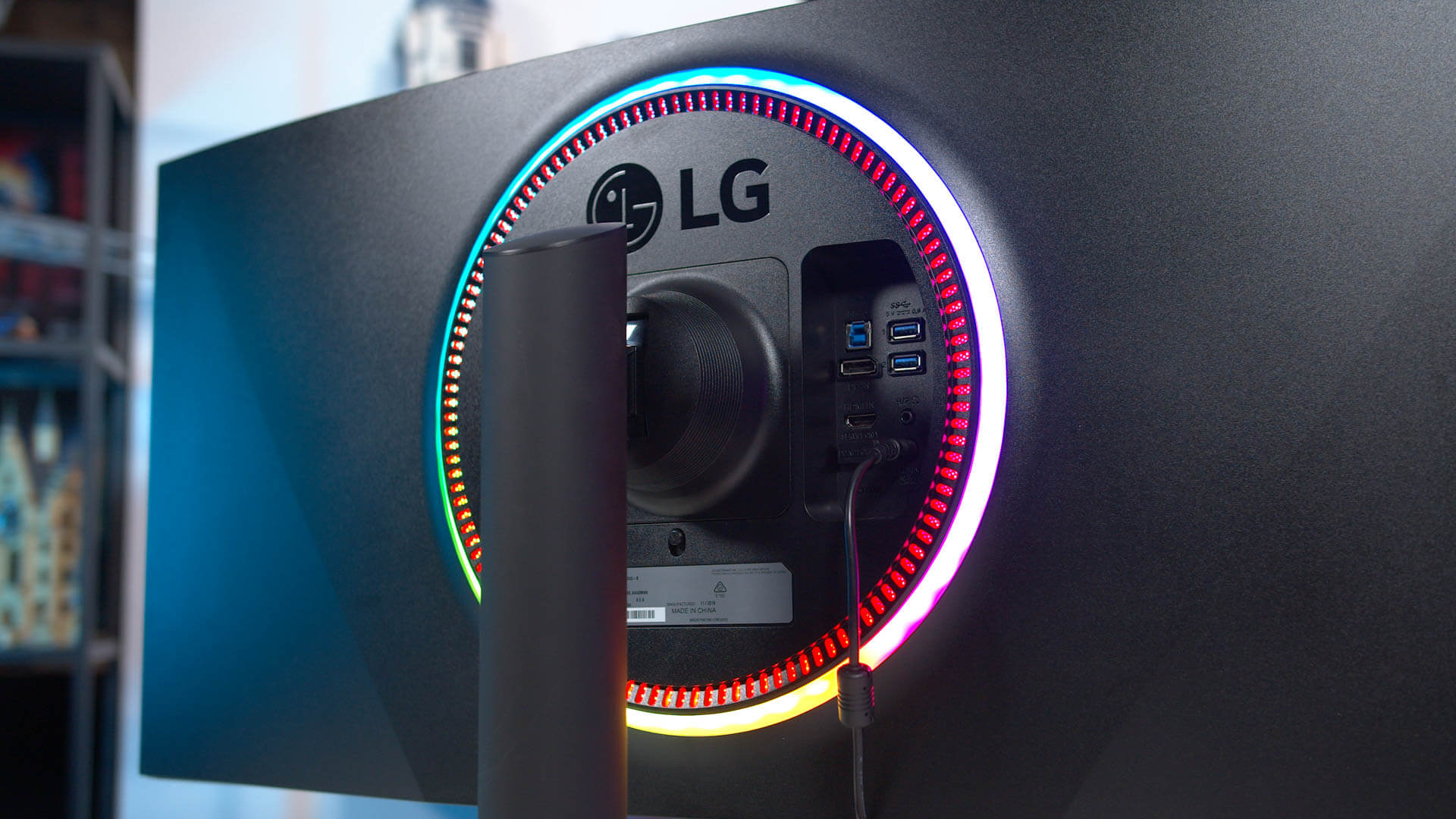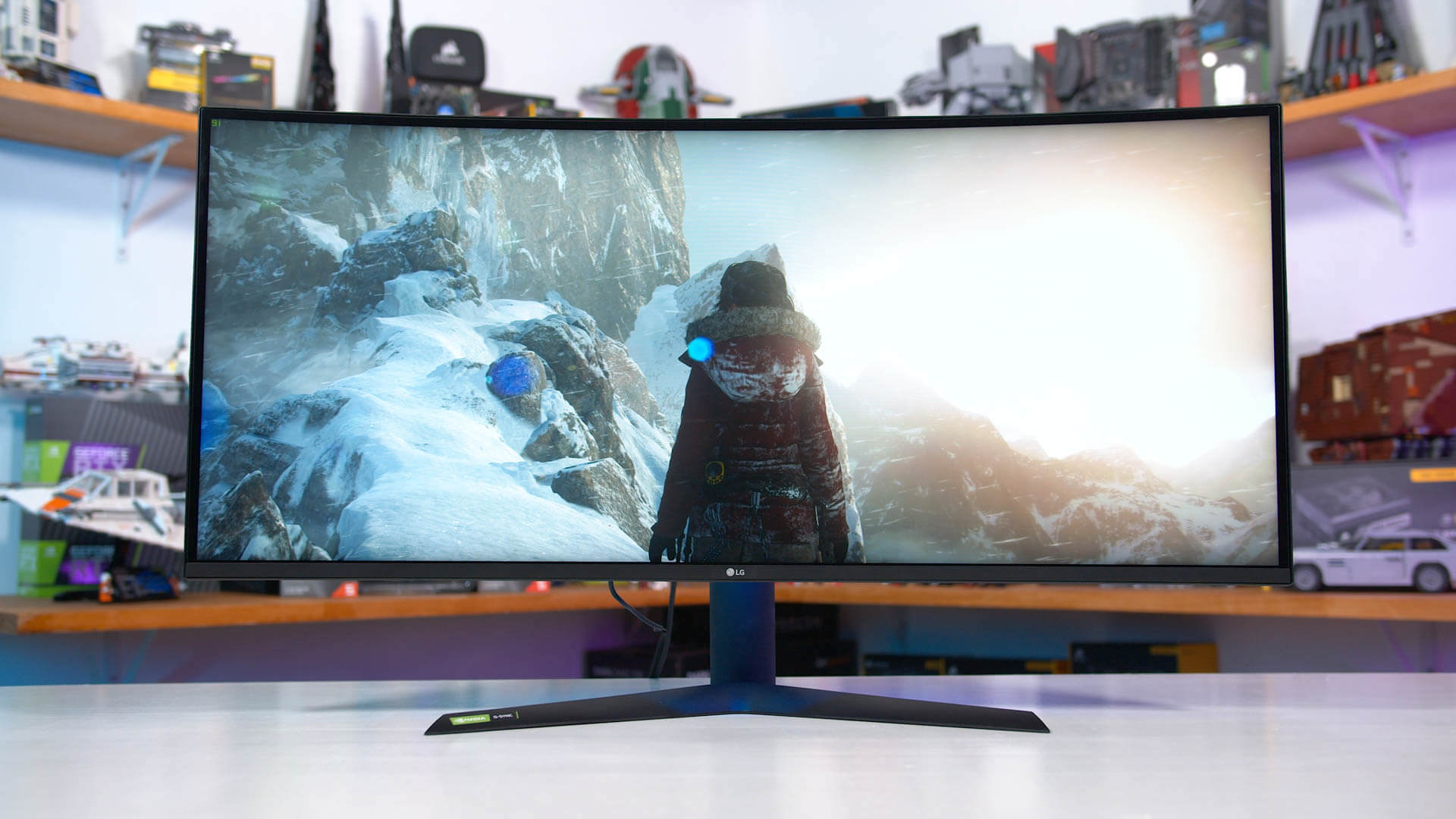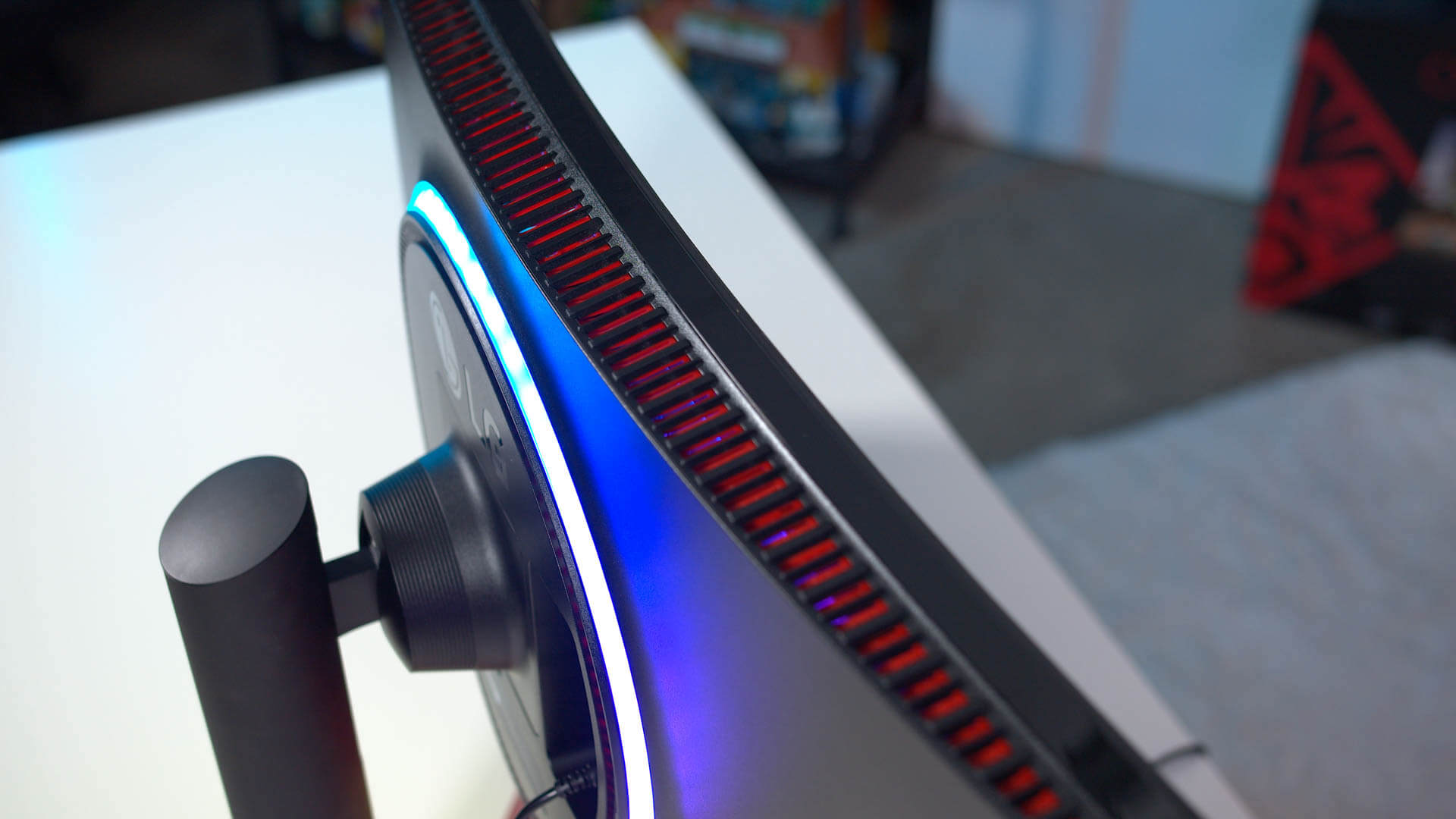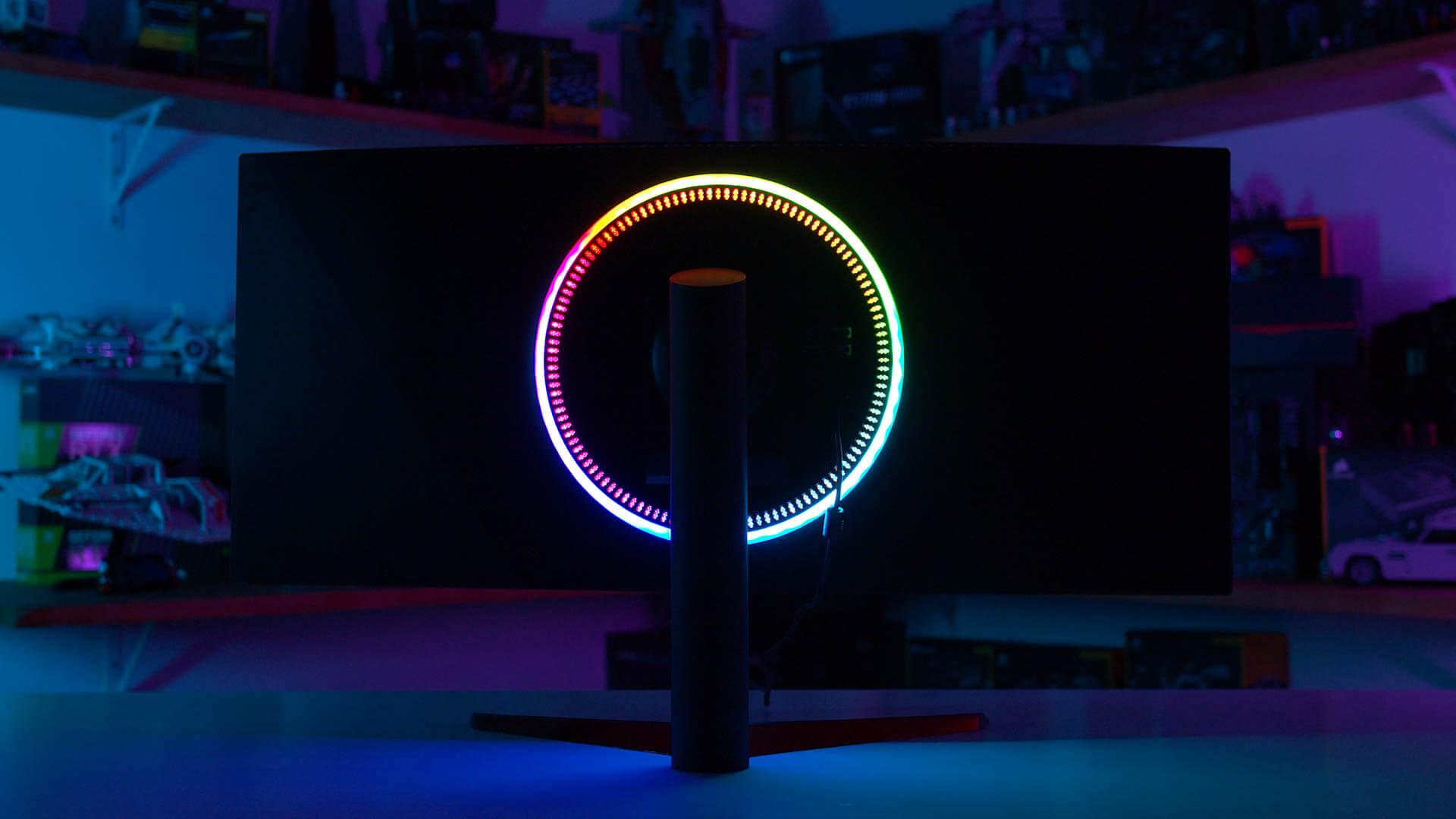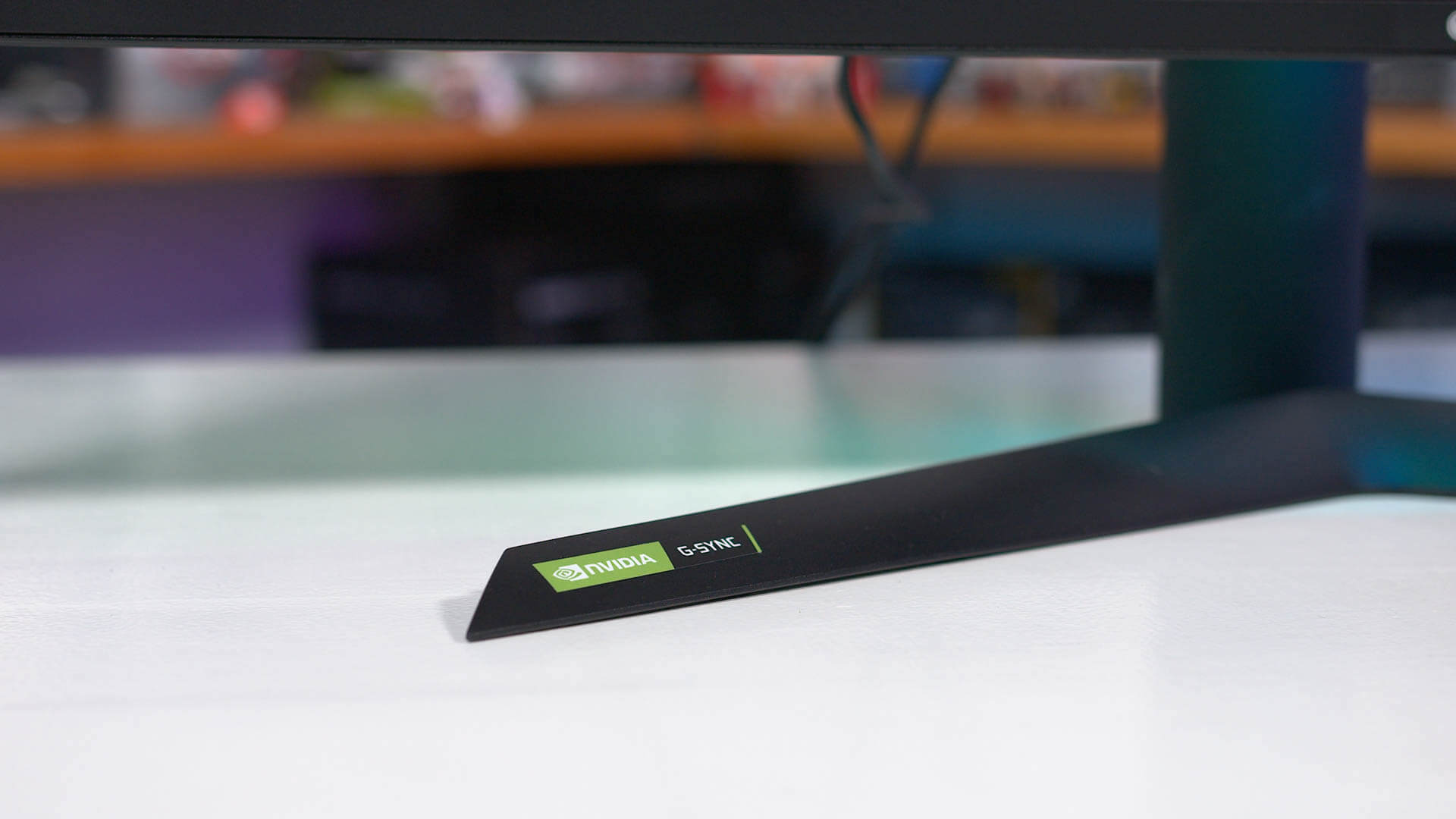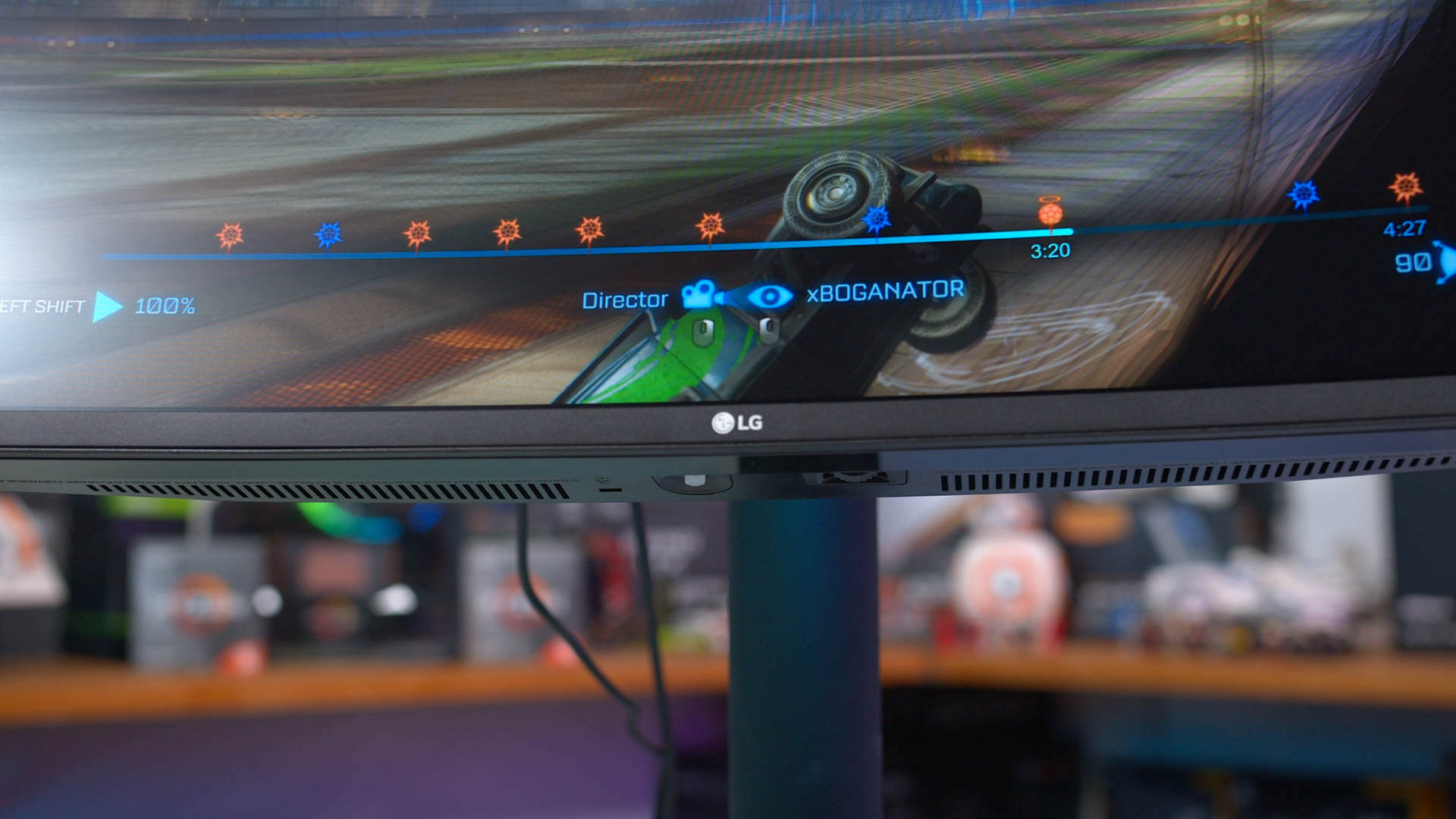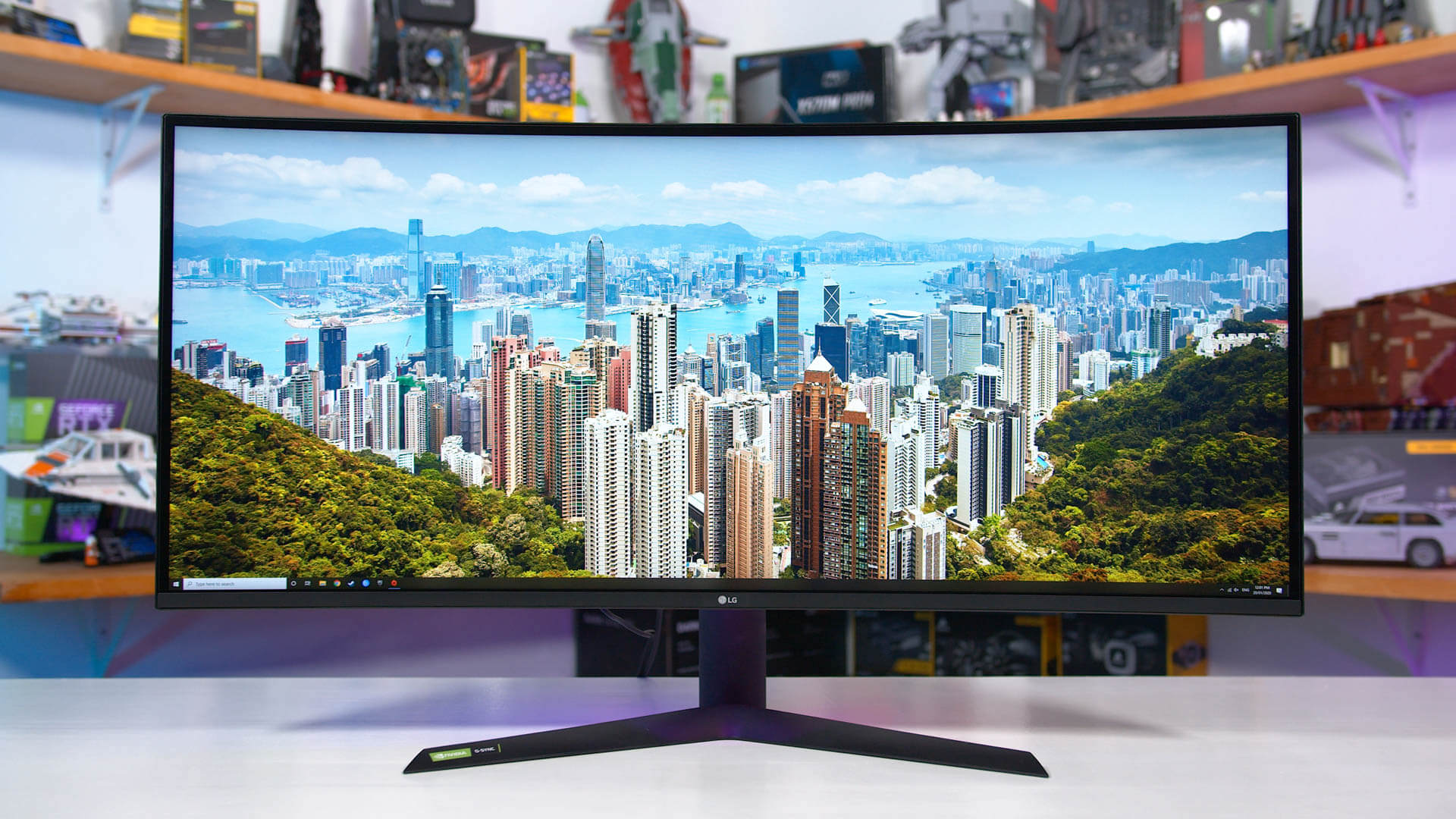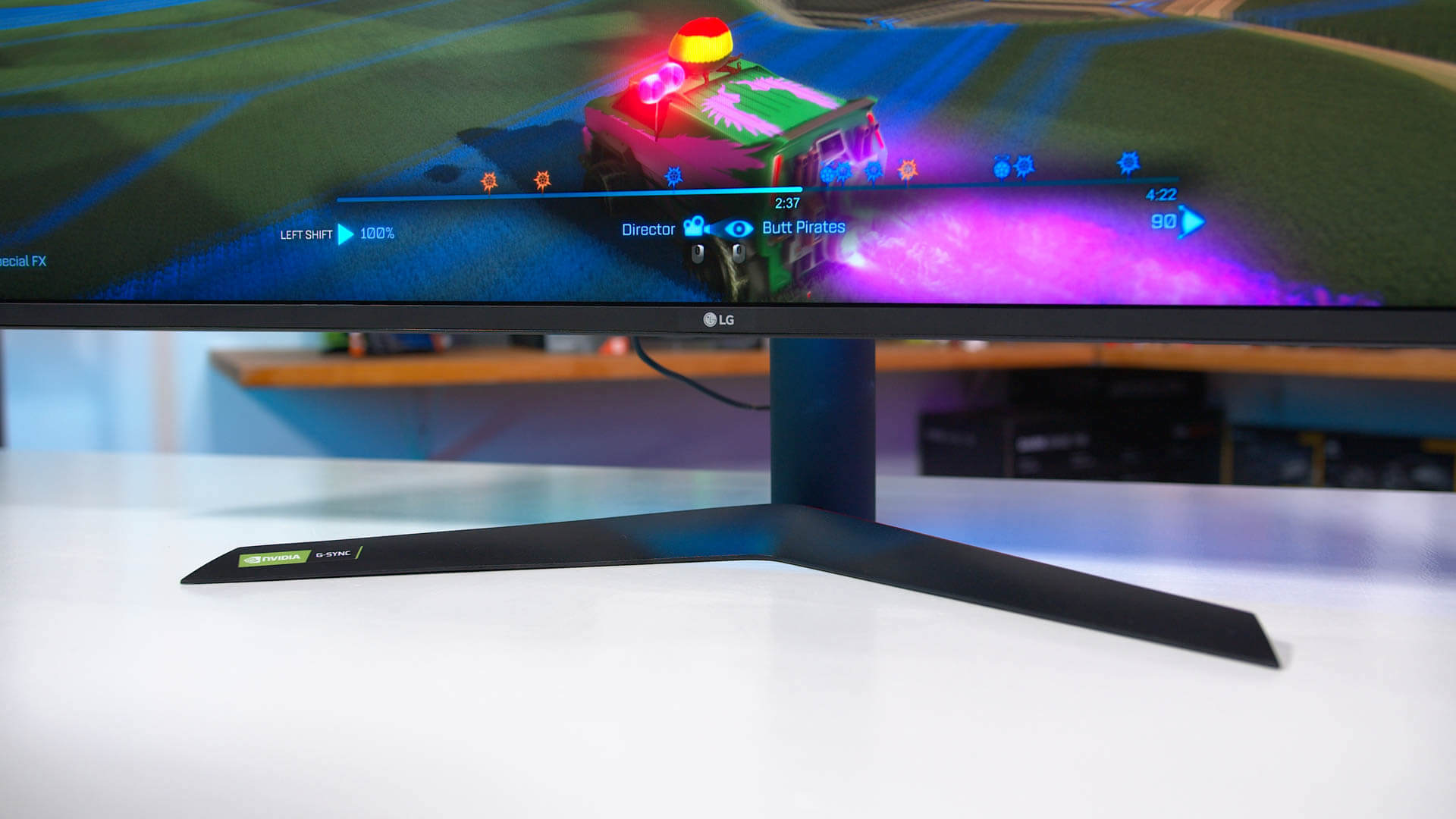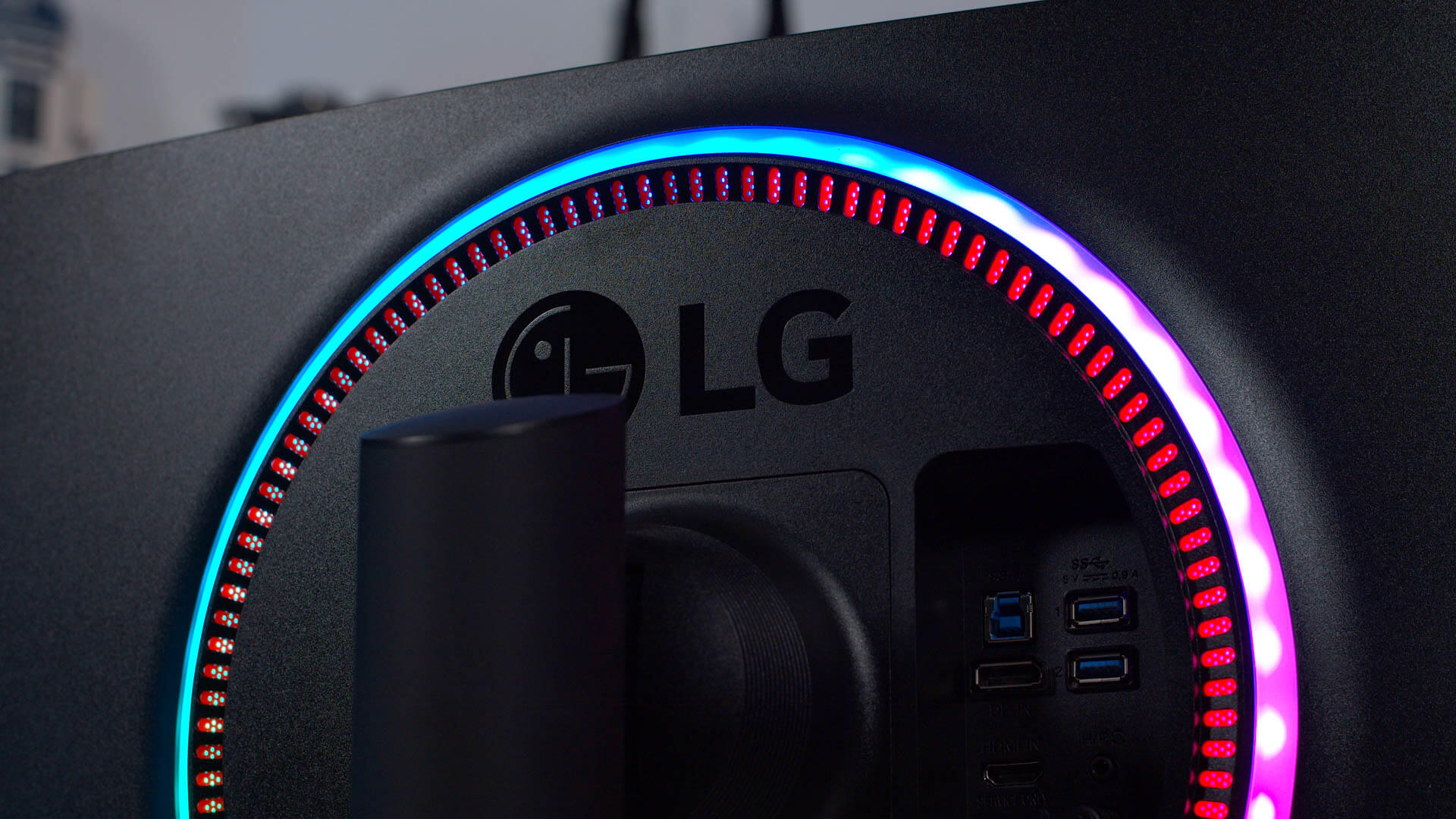The LG 38GL950G doesn't get the most user friendly name, but what you need to know is this is a high-end ultrawide monitor that has been on our radar for some time now. Unveiled back at CES 2019, this monitor has been a long time coming and just went on sale recently, so here's our full review.
The 38GL950G sports a new display format: 37.5-inch panel with a 3840 x 1600 resolution. This gives it roughly the same pixel density as 3440 x 1440 displays we've had for a while, and about the same aspect ratio. Technically neither format is exactly 21:9 but it's close enough. The result is the same sort of experience as 3440 x 1440, but from a larger screen, about 9cm wider and 3cm taller.
This LG monitor also uses new Nano IPS technology, which we first saw deployed in the LG 27GL850. This allows for a wide gamut experience as well as super fast response times. LG claims 1ms grey to grey and while the 27GL850 doesn't actually achieve this with usable settings in the real world, it's still the fastest IPS technology out there, approaching what is possible from TN panels.
We're also getting a very high refresh rate of 175 Hz, going above what's been delivered with 3440 x 1440 monitors, which currently top out at 144 Hz unless you buy the very expensive G-Sync Ultimate HDR models.
This combination of features promises an immersive ultrawide gaming experience with excellent motion handling. Indeed, the technology in the LG 27GL850 is set up to push ultrawide monitors further than they've gone before.
When we first heard about this monitor the specs were fairly unique, although another year and another CES has come and gone and we've seen a few other 3840 x 1600 monitors announced, including some from LG with different HDR capabilities and different refresh rates. Who knows when those are coming, but even then, LG is positioning the 38GL950G as the best of the lot.
Other features include full G-Sync with Nvidia's module inside. That provides real-world benefits which we'll talk about in a bit, but as we all know, it also pushes up the price. There is some limited HDR functionality with DisplayHDR 400 certification, but we wouldn't get too excited about that.
This is an expensive monitor. It's currently listed on Amazon for $1,800, which is $800 more than LG's previous flagship, the 34GK950F. It's also more expensive than most ultrawides on the market, not quite up there with the $2,200 price tag of the Acer Predator X35, but this is high-end territory.
But even if you're not interested in such an expensive monitor, the performance we'll go through shortly will give you a good idea how this panel will perform in other more affordable options that are set to hit the market soon. It's a very interesting display in our opinion.
Design
The monitor's design is very similar to previous LG UltraGear monitors we've seen. There's reasonably slim bezels on the front, a wide V-shaped stand with black and red plastic, a cylindrical pillar made of metal, and a back minimalist rear. You'll spot a few more red highlights, like with the top vented area. It's not the slimmest monitor ever, it's got a bit of chunk to it, but that's not unusual for a curved ultrawide.
The rear includes a feature LG calls Sphere Lighting 2.0, which is an RGB LED ring around the pillar and ports. We've seen plenty of RGB lighting on a monitor, but we think this is the best implementation. There's many more RGB lights than we usually get, and they're very bright. Often the issue with RGB lighting on the back of monitors is they're dim and can really only be seen from the rear, which typically faces a wall. Well with this, the lighting is bright enough to create an ambient effect around the display.
And that's good news because with LG's software, you can sync up the RGB effects to what is shown on the screen for added ambient. This works best in a dark room, but even in a well lit office you can still see the lighting to an extent. Normally we just pass off RGB on a monitor as complete rubbish but this is surprisingly good.
We also like the stand LG has used here. It has decent height adjustability plus tilt support, but most importantly, it's very sturdy. This is a big, wide screen and any wobbles could easily be magnified at the edges simply because of how big it is. But no, this stand is strong and withstands a bit of punishment with ease.
The on-screen display is controlled through a directional toggle on the bottom edge and it's a good OSD too. It's quick to navigate and includes handy features like crosshairs and FPS counters. However, like the 27GL850, there's no backlight strobing mode available for even more clarity improvements, we'd have liked to see that.
Port selection is standard for monitors that use Nvidia's G-Sync module: one HDMI port and one DisplayPort. There's a USB hub, too. And let's take a brief moment to talk about what you can and can't do with these ports because there are some restrictions...
With DisplayPort you can use up to the 175Hz max refresh rate, but even with 8-bit color you'll be limited to chroma subsampling at the max refresh and resolution. However, 8-bit color is achievable at 160Hz. For 10-bit color you'll need to drop down to 120Hz, although of course, you can still use HDR with 8-bit color if you'd prefer the higher refresh rates. Meanwhile, the HDMI port is limited to 85 Hz, so we wouldn't use it.
Without Display Stream Compression or DSC, which leaves us with chroma subsampling at the maximum refresh rate, we think most people will prefer to use this monitor at 160Hz to get that crisper, clearer experience, particularly on the desktop. The difference between 175Hz and 160Hz isn't massive but it is a bit disappointing the maximum refresh mode is restricted in this way. Hopefully a future revision will support DSC and alleviate this problem.
Couple of other quick notes. You may have heard Nvidia's latest generation G-Sync module also supports VESA adaptive sync (a.k.a. FreeSync), allowing you to use G-Sync monitors with AMD GPUs and still get a variable refresh rate. This is one of those monitors, so it does come with the newest variant of the G-Sync module. We repeat, the variable refresh experience on the LG 38GL950G is available with both Nvidia and AMD GPUs.
There is a small cooling fan inside this monitor, however in our experience it's virtually silent and nothing to worry about. It's definitely quieter than some G-Sync Ultimate monitors.
Display Performance
Response Times / Overdrive Modes
Let's look at response times first. LG provides four overdrive modes with this monitor, claiming a 1ms grey to grey response only at the maximum Faster mode. However, performance is still very strong even with overdrive off. At 175Hz, we saw a grey to grey average of 6.40 ms with this setting, which is very quick by modern IPS standards. Normally an IPS panel needs overdrive to achieve these sorts of response times and even then, some monitors don't get this quick.

Normal is a step up again, about 1ms faster, but it's the Fast mode where the 38GL950G really flexes its muscles. Here we are getting an incredible 3.17ms grey to grey average with levels of overshoot that are present, but manageable. 85% of transitions had no problems, it's only with a few close together transitions that overshoot exceeds 20% or so. And in gameplay we found these issues virtually impossible to spot. With these sorts of speeds, 100% of transitions fall within the reasonably tight 5.71ms response window for 175Hz gaming, which is perfect.

However, as you might have noticed, this isn't technically a 1ms monitor at this overdrive mode. For that, we need to push up to Faster and... same problem as the 27GL850. Overshoot is incredibly high here, resulting in obvious light trails to any moving objects on the screen. The grey to grey average is 1.83ms with some transitions completing in less than 1ms, but that doesn't matter much when overshoot is so high.
And while this mode is unusable and the monitor isn't really 1ms capable, we don't want to take away from what is otherwise a very fast IPS monitor experience. Usable speeds in the 3ms range is outstanding.

What's even better is how the 38GL950G holds up across the refresh rate range. At 160Hz the experience is essentially the same as 175Hz, which is great news for those that don't want to deal with chroma subsampling. Then at 144Hz, overshoot gets a little worse but even then, this is still a usable experience, similar story at 120Hz, which still delivers sub-4ms response times.





From there it actually gets better. At 85Hz, overshoot is reduced substantially, with response time averages only creeping up to 4.56ms. Then at 60Hz we see similar overshoot with slightly higher response times, now up to 5.12ms. While this is a bit slower than what is possible up at 175Hz, had LG kept 3ms-type performance at 60Hz, we likely would have seen considerable overshoot, so the better option is to drop down speeds a bit here. And 5ms is still quite quick.
We're also seeing the result of variable overdrive, which you get with all full G-Sync monitors through Nvidia's high-end G-Sync scaler. You'll notice that we didn't have to change the overdrive setting to get excellent results at 175Hz through to 60Hz, we were able to comfortably keep it on Fast without any issues. And performance did noticeably change between 120 and 85 Hz to maintain acceptable overshoot levels, which is what variable overdrive does, it modifies the level of overdrive depending on the refresh rate.
Now variable overdrive is possible on non-G-Sync displays through traditional scalers, but it's rarely implemented, so one of the few ways to get it is with full G-Sync monitors.
Some panels need this tech to deliver the best performance at all refresh rates, some don't, but this is a tangible benefit to having G-Sync with this display. Whether this is worth the price premium depends on how response time sensitive you are.
Looking at the comparison chart below, the 38GL950G looks very impressive. It doesn't have the absolute fastest response time we've tested, but it sits among TN monitors like the speedy Gigabyte Aorus KD25F and HP Omen X 27. For an IPS monitor with significantly better colors and viewing angles, that's unprecedented. Performance is simply outstanding.

There are some other noteworthy comparisons to make here. Overdrive is better tweaked with the 38GL950G, so it's faster than the 27GL850. We think both panels perform similarly overall, but the 38GL950G is much closer to its limits and has variable overdrive as well.
Compared to other ultrawide monitors, the nearest competitor is the Acer X35, although it's slower and being a VA panel, has issues with dark level smearing and overshoot to a certain extent.
You can see improvements over LG's previous generation monitor, too. The 34GK950F is good with a 5.14ms grey to grey average, but LG has shaved off nearly 2ms which is significant and allows for a clearer image in conjunction with its faster refresh rate. Budget ultrawides offer more like 7-8ms response times and are not in the same performance class.

We see the benefits of IPS with the dark level average performance. Previously you saw the X35 come close to the 38GL950G, but the X35 falls down the ladder due to the inherent limitations of VA panels.

Response time compliance is perfect, even at its high 175Hz refresh rate, a feat many monitors could only dream of. The downside are error rates, which is where the differences between LG's Nano IPS and most TNs come to the forefront. The 38GL950G is being run at its limits, hence higher error rates, whereas most 3ms TNs we've tested hit that sort of speed with relative ease. The 38GL950G is hugely impressive, but Nano IPS panels aren't at the level of TNs yet.

You see this with our inverse ghosting chart. The fastest TNs out there with 0.5ms class response times hit very quick responses with no overshoot issues, like the Gigabyte Aorus KD25F, for example.
At 60Hz, the 38GL950G is still a strong performer despite falling back to a 5ms grey to grey average. It is beaten by the 27GL850, which also maintains strong performance without needing to change its overdrive setting, but that's a different Nano IPS panel.

Input lag is great with processing lag below 1ms, a fast refresh rate and quick response times all combining to deliver end-to-end lag of under 7ms, which is elite level performance.

Power consumption is higher than 34-inch equivalents which is to be expected given the larger panel size and those bright RGB lights on the back. 62 watts is still reasonable though, but perhaps not the most efficient on this list.
Color Performance
Another area where the LG 38GL950G performs well is color reproduction. LG lists this panel as being factory calibrated and that's true based on our testing.
Out of the box, CCT performance is strong with a near perfect temperature and gamma curve, allowing for a 1.09 deltaE average from the factory, which is much better than most monitors.
When measuring against sRGB, it does suffer from not shipping with an sRGB clamp by default, although it does have an sRGB mode we'll talk about in a moment. So if you don't enable the sRGB mode, you will get oversaturated colors and deltaEs in the 2.0 to 3.0 range. Which is still pretty good for a gaming monitor, but not perfect.
Default Color Performance
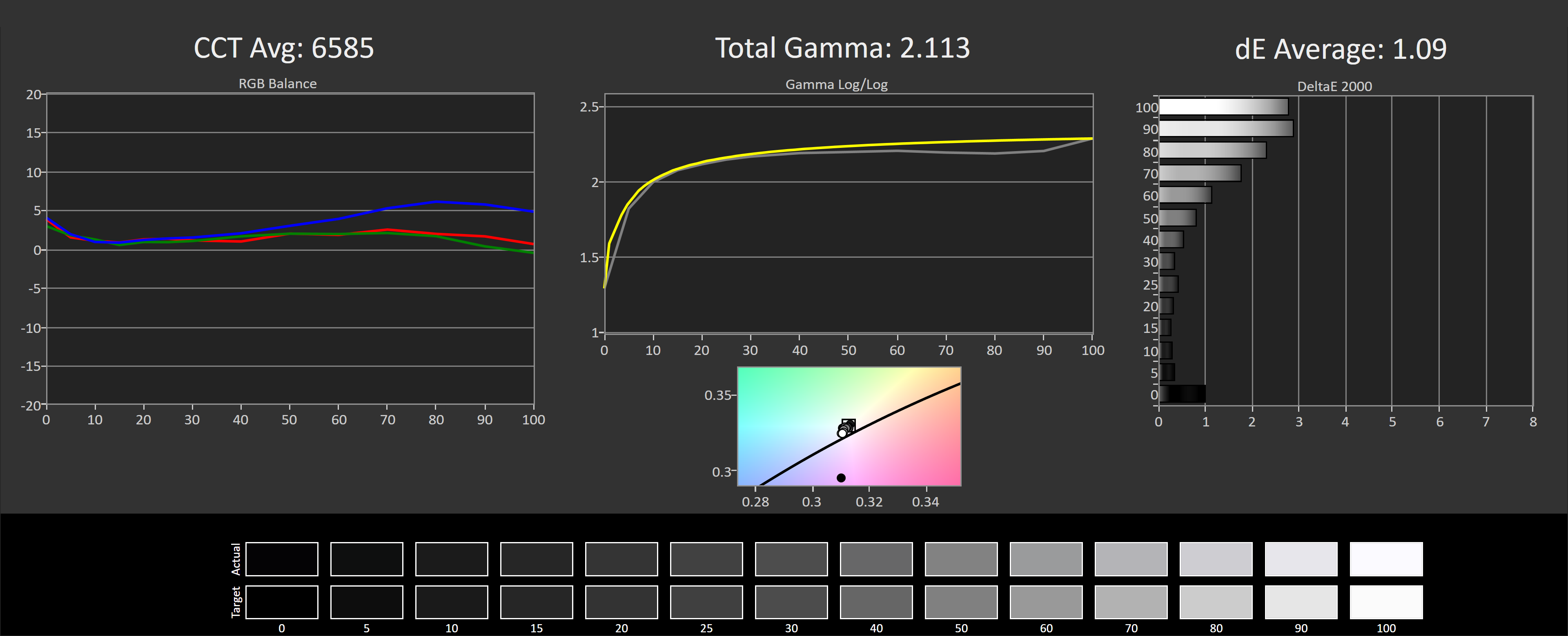
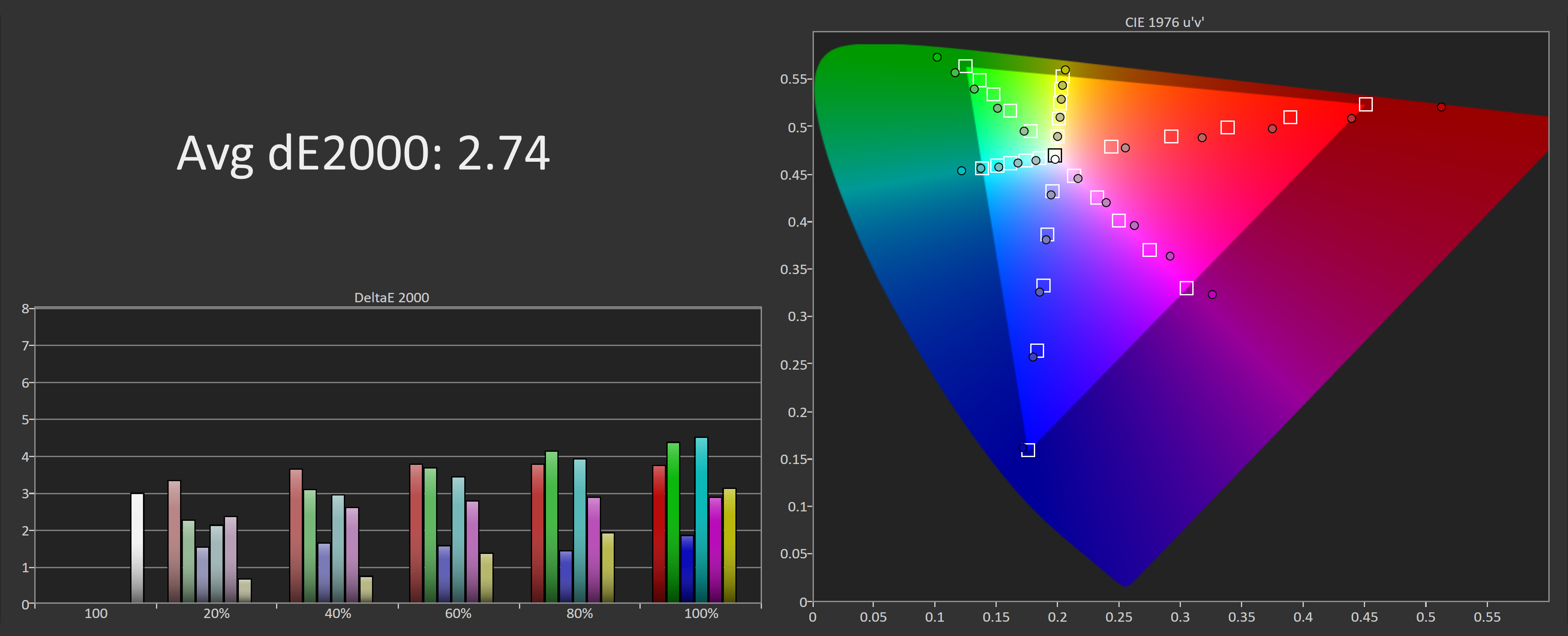
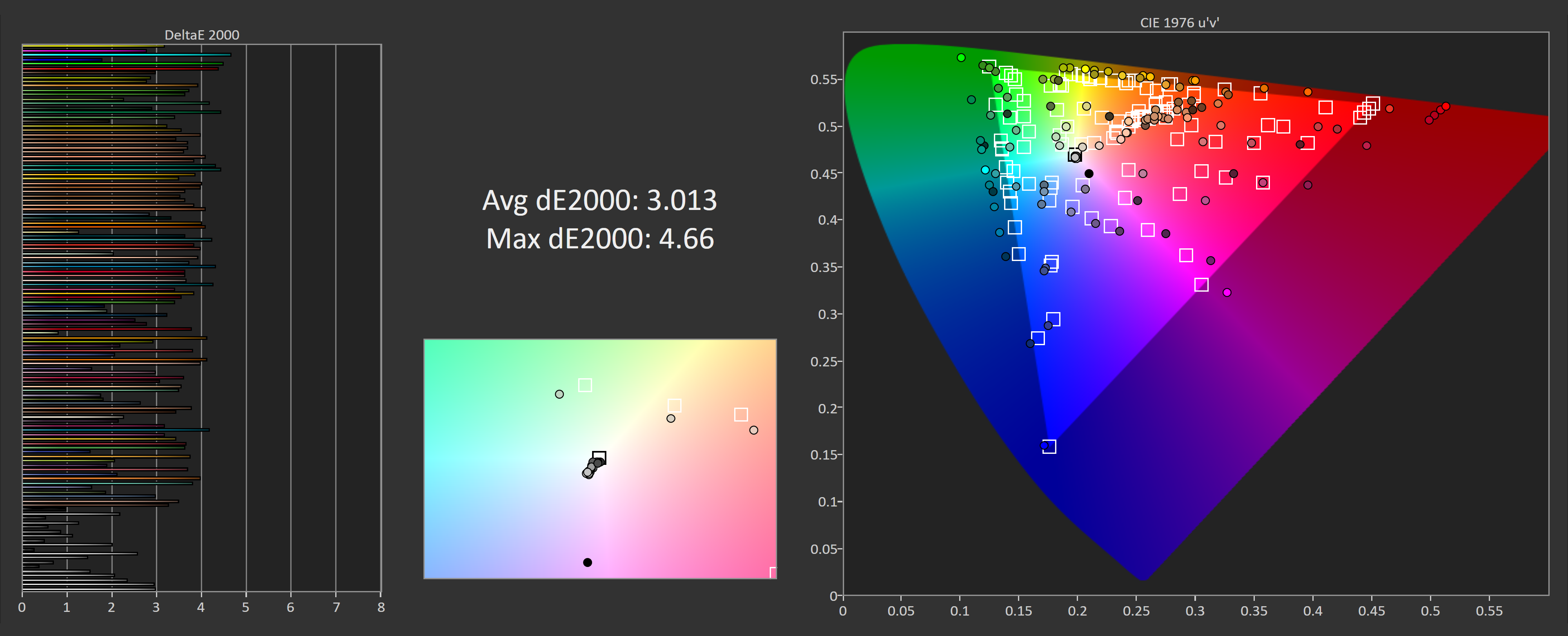
sRGB Color Performance
What about the sRGB mode? Well, it's pretty good. The top end of greyscale is tinted a bit blue – at least with our review unit – and unfortunately you can't correct that in the OSD as the color temperature setting is greyed out. A deltaE of 1.76 is still very good but ideally the sRGB clamp this mode provides would also be accessible in a different mode that allows color temperature tweaking just to correct any slight issues with the unit from the factory.
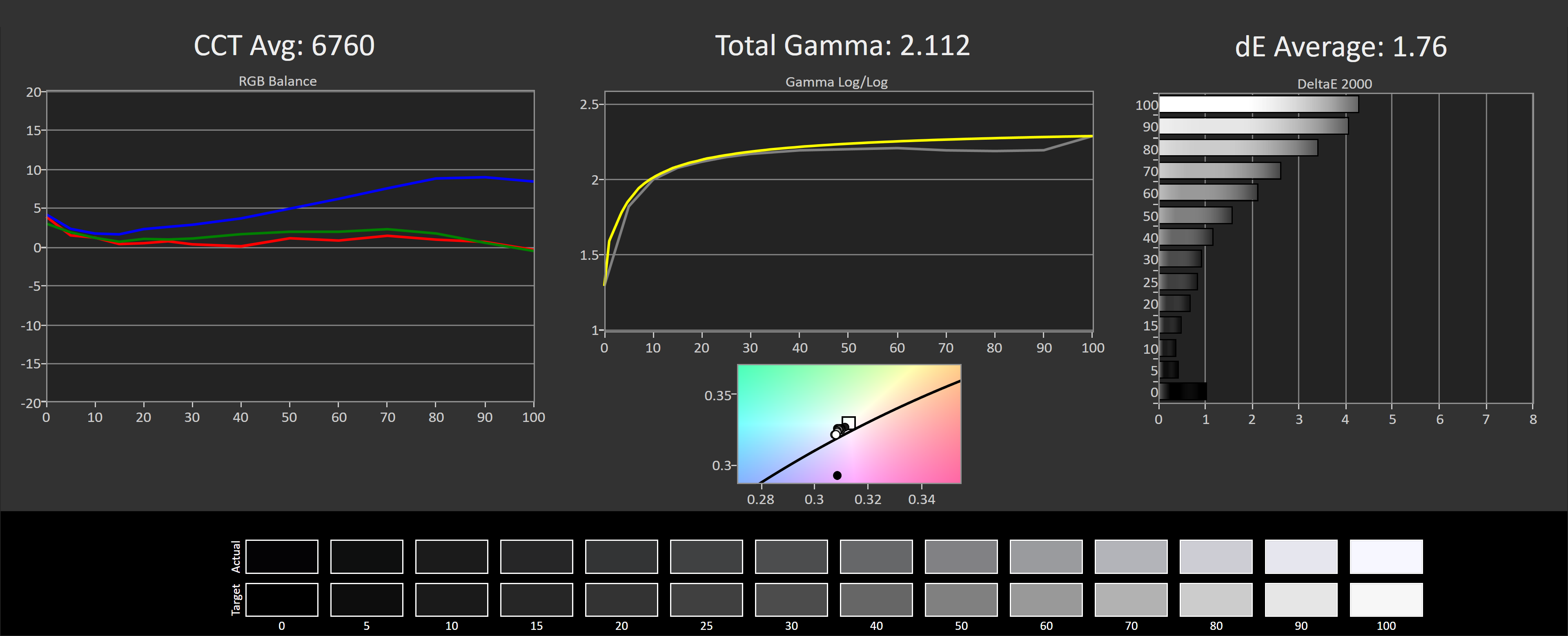
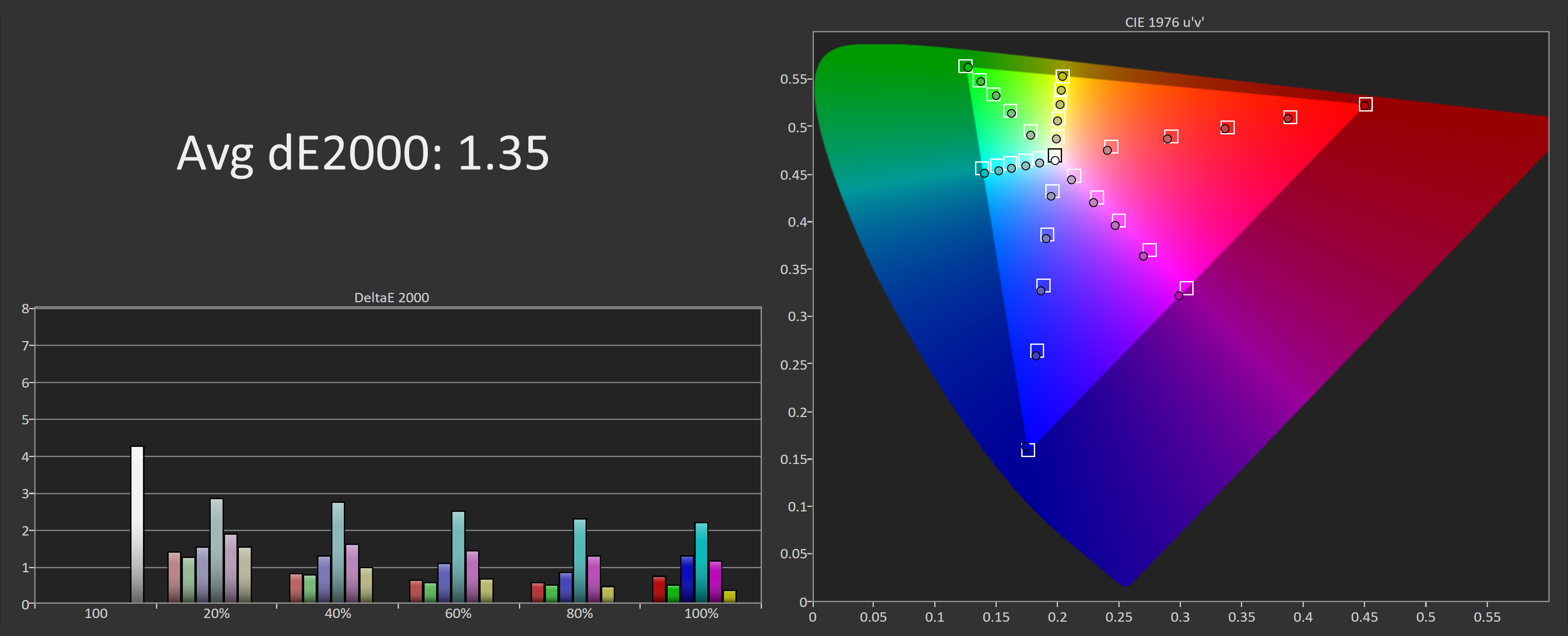
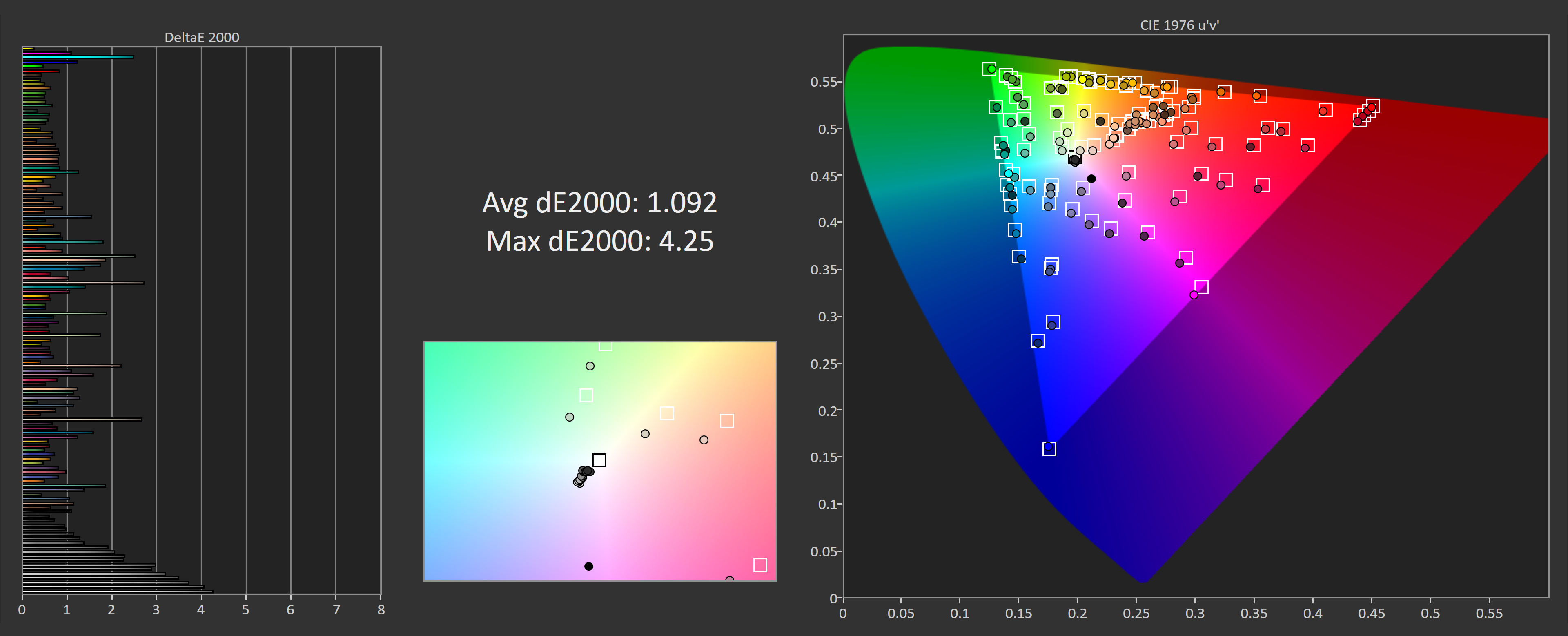
Did we say sRGB clamp? Yes, that's what the sRGB mode provides, meaning sub-2.0 deltaEs are possible. If you want sRGB accuracy out of the box, we'd recommend using this mode despite some issues with color temperature. All things considered, it's the best mode to use for displaying sRGB content.
D65-P3 Color Performance
D65-P3 performance is also strong out of the box. Grayscale performance is similar to what we've been discussing, with saturation and ColorChecker deltaEs also below 2.0. This is the sort of factory calibration we like to see. Basically we have two modes that provide decent sRGB and P3 performance without the need for tweaks.
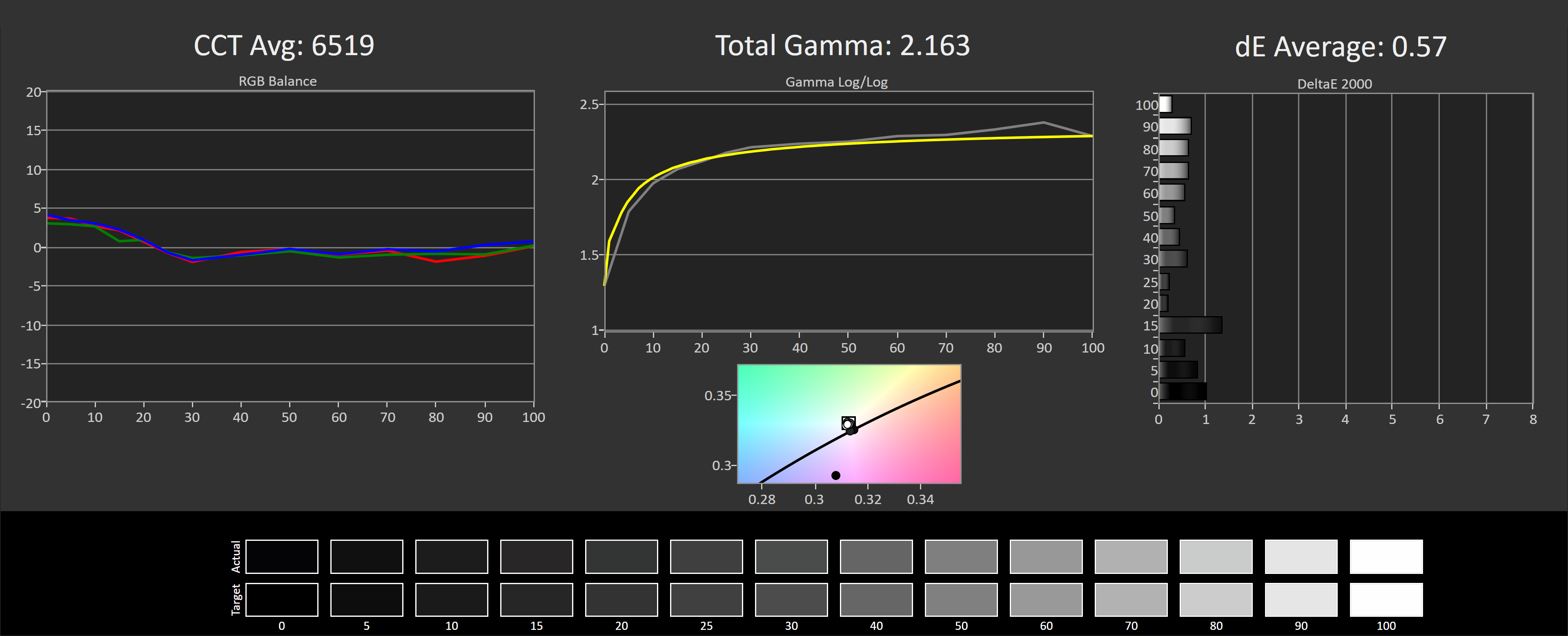
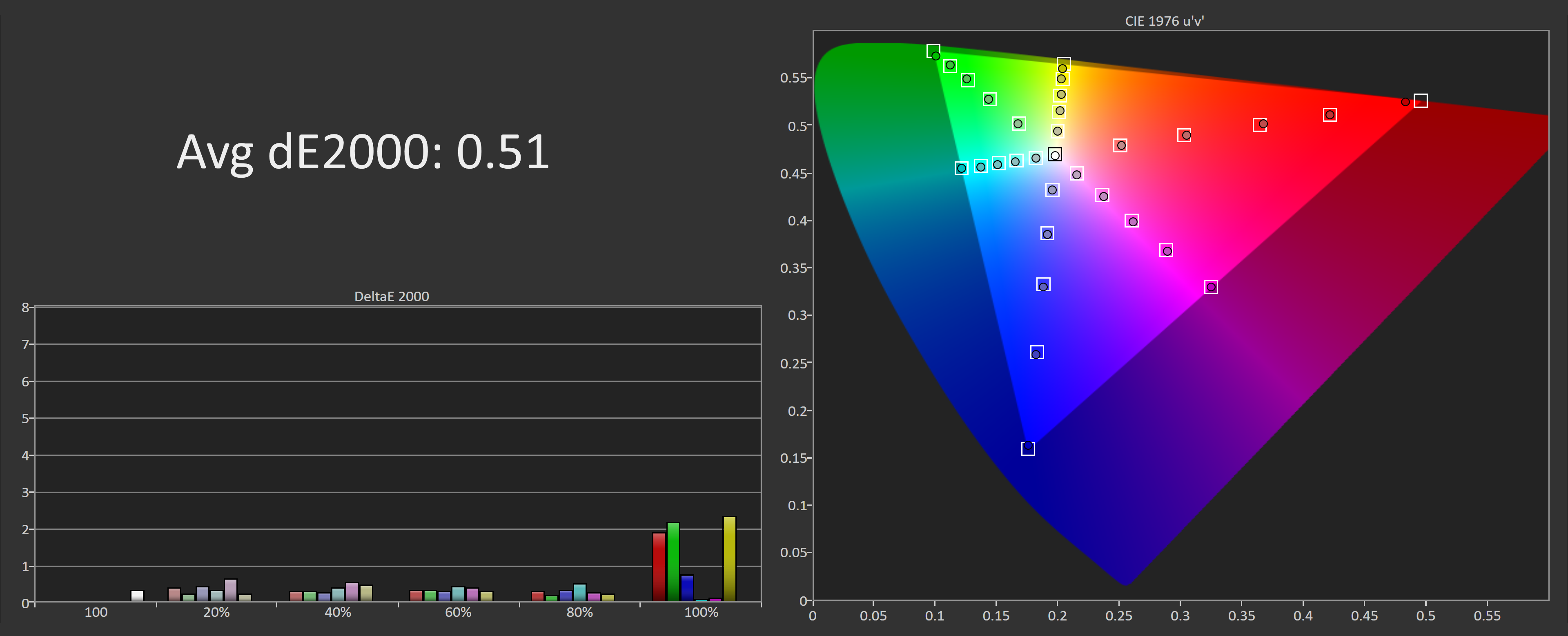
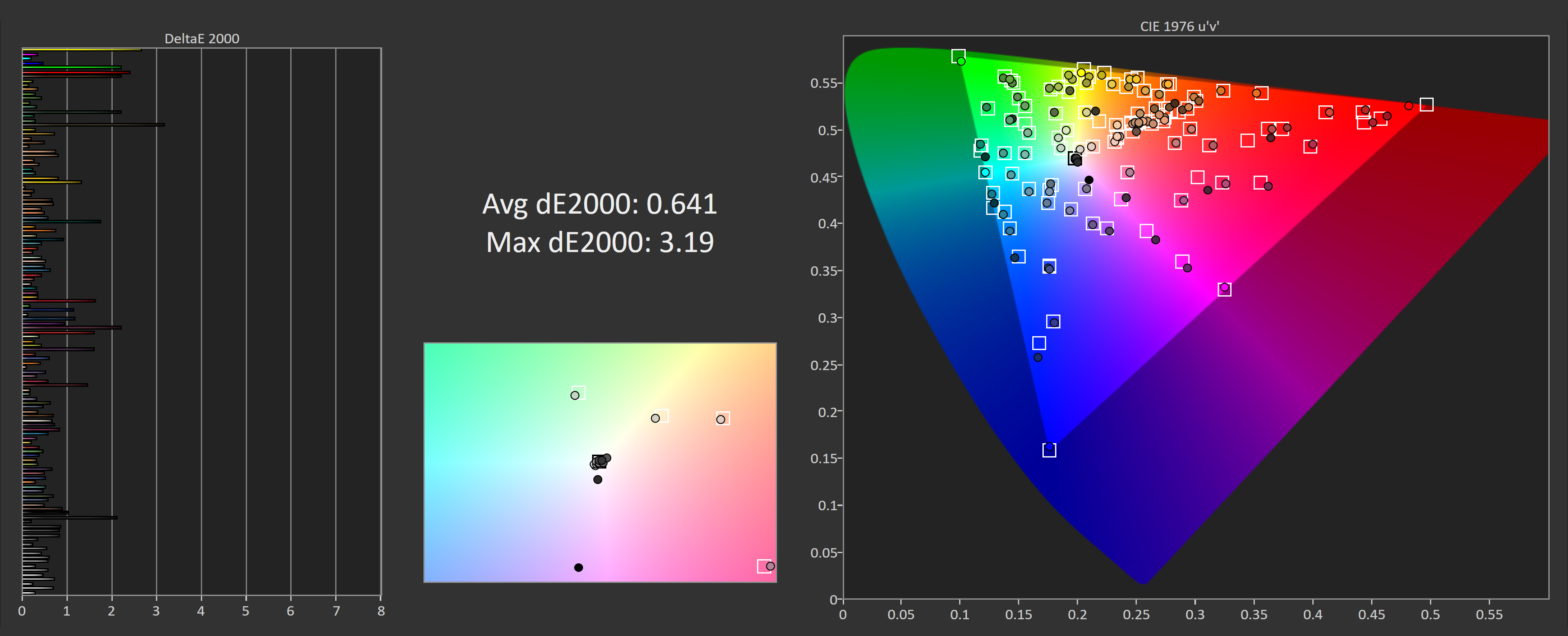
Calibrated Color Performance
From here we can do a full calibration using DisplayCAL, which sees all the remaining issues tightened up completely. sRGB deltaEs around that 0.5 mark, and similar with P3. However we aren't quite getting full P3 coverage, we're still limited to around 95% with this panel - a very good result among consumer IPS monitors - but this leads to some slight clipping right at the top end when displaying wide gamut content. If you're a perfectionist this may be of concern, otherwise this is a great result from a gaming focused monitor.
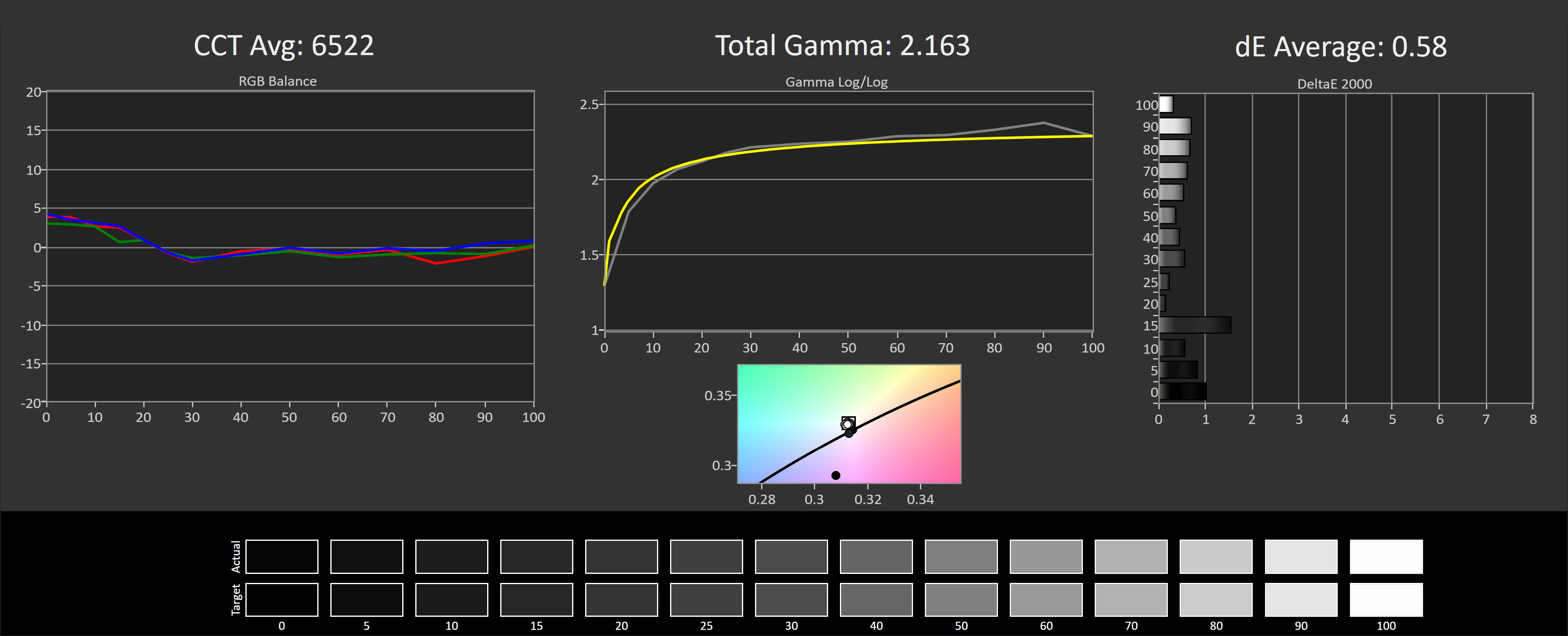
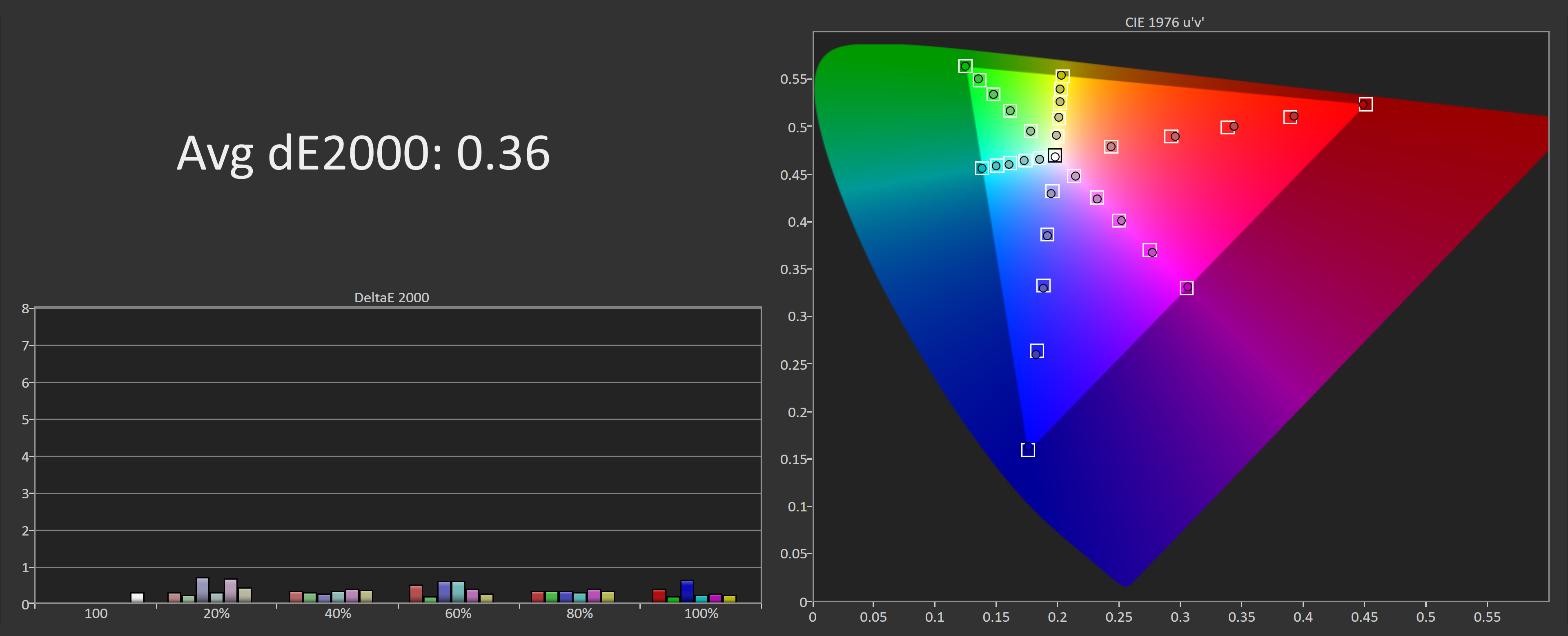
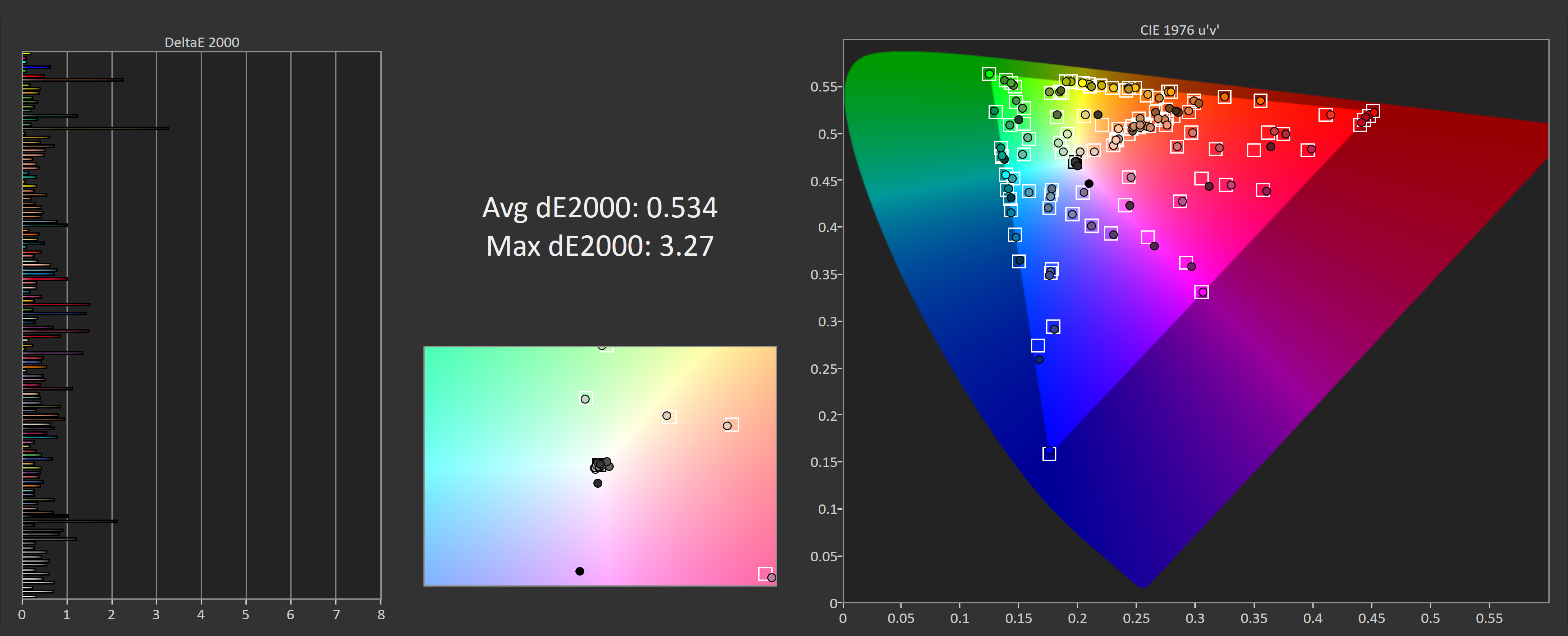

The 38GL950G delivers over 400 nits when calibrated, which is very bright, meaning no issues with panel brightness. Viewing angles are excellent, too, not quite the best IPS viewing angles we've seen, but significantly better than TN and many VA offerings.
IPS glow was minimal with our review unit, too. Many people get concerned when buying IPS monitors that they'll get terrible glow but most current-gen panels we've seen don't suffer from severe glow problems.
If you've read other reviews covering Nano IPS displays, you'll know that contrast ratios and black levels are a problem. Unfortunately, that is true of the LG 38GL950G as well. We measured a contrast ratio of 879:1 after calibration, which is a bit better than our 27GL850 unit. However, it's still not great, staying within the realms of TN panels rather than pushing up to the 1000:1 and above that we expect from the best IPS monitors.

What does this mean in practice? If you game under artificial lights or during the day, it's unlikely you'll notice any issues with contrast ratio compared to other types of monitors. This is because ambient light interferes with observed black levels to an extent. It's only in darker viewing environments where the 38GL950G falls behind other monitors, especially VAs.
While this is a poor result for Nano IPS panels, we think it's important to note that even though contrast is similar to TNs, the 38GL950G and 27GL850 have a significant advantage over TNs in viewing angles and color performance. It seems that a sacrifice to improve response times to near-TN levels has been contrast, which is an area we'd rather see hit than viewing angles to be honest.
And even then, the 38GL950G is only 8% behind the 34GK950F in terms of contrast and 15% behind the Pixio PX7 Prime, so it's not as bad as it might seem.
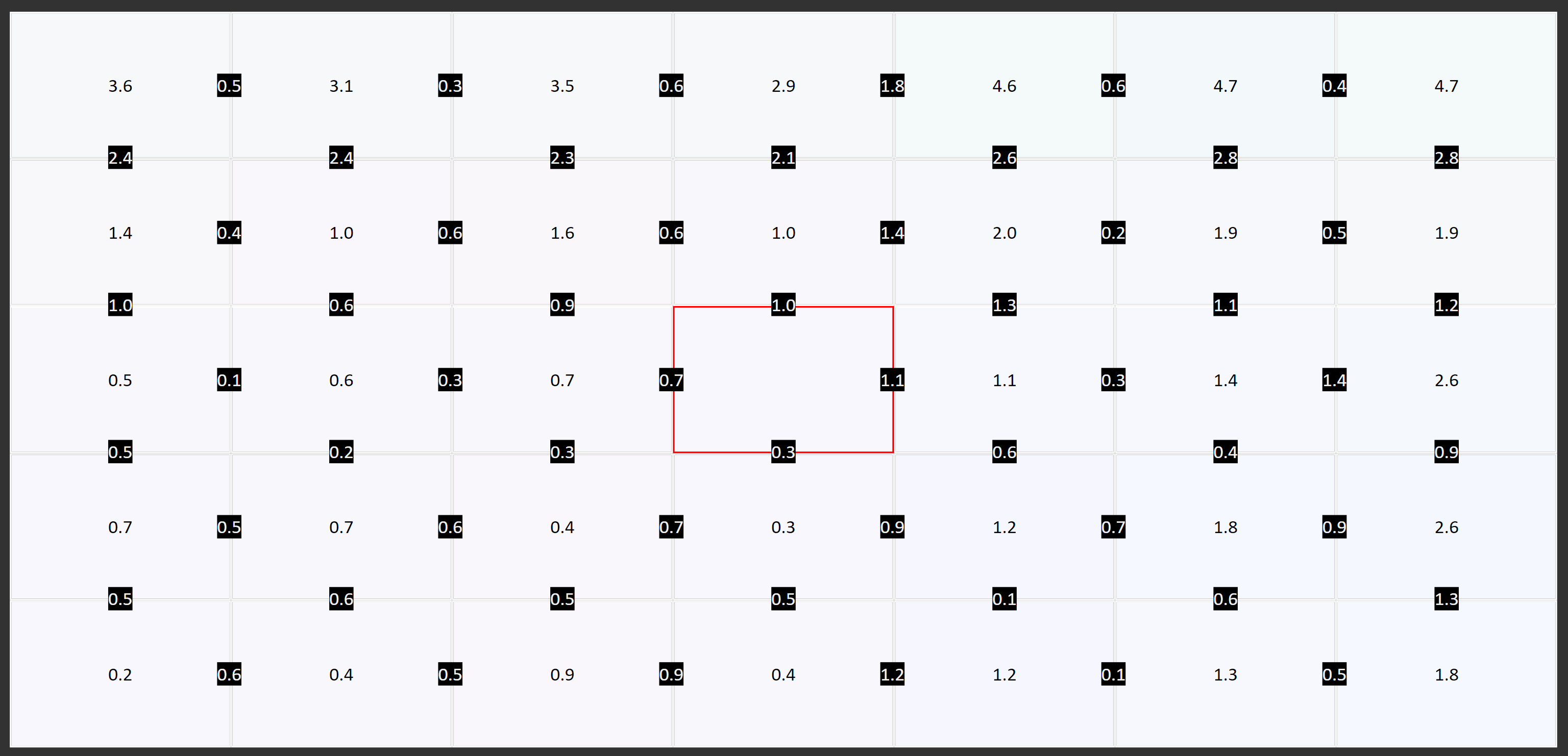
Uniformity is good, but not perfect. The center section of this display is strong, but our unit did have a slight vignette effect along the top and bottom edges, which is noticeable during regular usage. For an $1,800 display, vignetting is not a good result, but at the same time it's not a major issue and it's not noticeable while gaming.

Finally, we get to HDR. We won't dive into this much because the 38GL950G lacks local dimming, so it realistically cannot display single-frame contrast ratios above 1000:1. This means the actual dynamic range of this monitor is "standard" not "high" like you need for HDR, so we aren't getting a true HDR experience. Brightness also falls behind required targets, hitting just 460 nits in its HDR mode.
I will say that HDR input support is actually good, so the monitor doesn't look like trash when you enable the HDR mode in Windows, but the actual picture quality isn't in the same league as true HDR displays. You might find the HDR mode useful for wide gamut work, it's just not real HDR.
That was a ton of testing, hopefully for anyone waiting for an in-depth review of this monitor, all your questions have been answered. If you already read reviews of the LG 27GL850, you were already part of the way to uncovering how the LG 38GL950G performs, given it uses the same kind of Nano IPS panel technology.
Top-Notch Monitor: Who Is It For?
The LG 38GL950G is clearly the best ultrawide monitor on the market right now. Essentially it takes every feature we got with previous flagship ultrawide displays, and takes it up a notch. The resolution and panel are physically bigger, if only slightly, which we think is really good. We love this size and the bump up from 3440 x 1440 to 3840 x 1600 is handy. In our opinion offers a more immersive experience and it's also better for split-screen productivity work.
The refresh rate is also higher than previous monitor offerings that topped out at 144Hz, while now we're getting up to 175Hz – although with chroma subsampling – that's realistically 160Hz for full-quality viewing. The chroma subsampling issue is disappointing to an extent, but forgivable when it's still delivering a high refresh rate at a large resolution. The bump may not be large for those that already have a 144Hz ultrawide, but if you're coming from a popular 100 or 120 Hz monitor like the Acer Predator X34, this is a significant improvement in our opinion – and this is coming from a long time X34 user.
Most impressive of all are the response times, which are excellent. This is the first time we can say an IPS monitor delivers response times equivalent to TN monitors. It's a really quick display. A small amount of overshoot with the 38GL950G still gives the best TN monitors an edge in terms of overall performance, but the clarity in motion with this monitor is equivalent to a TN at the same refresh rate. It's a big upgrade over previous IPS panels that packed 5ms response times. Given the other benefits you get from IPS, this is a next-gen viewing experience.
Some will no doubt criticize this monitor's inability to actually hit a 1ms grey to grey average with a usable overdrive mode. But this is no different to TN panels. We've yet to review a TN monitor that hits 1ms on average either, and at this point we've looked at several that claim 0.5ms response times. Yes, we've seen 1ms and 0.5ms minimums, but not on average. The point is, the 38GL950G's best usable overdrive mode is still mighty impressive and comparable to optimized TNs.
The LG 38GL950G also delivers in other ways. Variable overdrive keeps performance rock solid across the entire refresh rate range. Even though it has a G-Sync module, it's FreeSync compatible and works with AMD GPUs. Input latency is very low. LG is factory calibrating these panels and the results are very good, both for sRGB in the sRGB mode, and for wide gamut usage.
Did we mention this is a wide gamut panel that has 95% P3 coverage? Yup, you get that, too. High brightness levels, excellent viewing angles, and a great design with functionally useful RGB lighting.
While in general this is an excellent monitor, it's not perfect, so let's acknowledge some flaws. The biggest is the contrast ratio, which is unimpressive against other IPS and especially VA monitors. Whether this is an issue for you will depend on how you view your monitor, with those that game in the dark the most affected. There's also the complete lack of true HDR functionality. Normally we can forgive a bit of slackness on the HDR front when the monitor is fine for SDR gaming, but given the high price tag of the 38GL950G, having proper HDR functionality is almost a requirement.
For a cool $1,800, this is not a small sum to pay for what admittedly is a really good monitor. If you're looking for better value, a number of 3840 x 1600 monitors with 160Hz refresh rates are set to hit the market soon, including LG's own 38GN950. Looking at previous ultrawide flagships, like the Acer Predator X34 and LG 34GK950F, those have typically been ~$1,000 to $1,200 at launch, which is still less than the new LG 38GL950G. That said, pricing on LG monitors tends to change often. They're known to discount products in the months after launch, so it wouldn't surprise us if this is selling around $1,500 mid-year.
Bottom line, if you've been eagerly awaiting to upgrade to a best in class ultrawide for gaming, the LG 38GL950G is a fantastic monitor and one of the best displays on the market.
